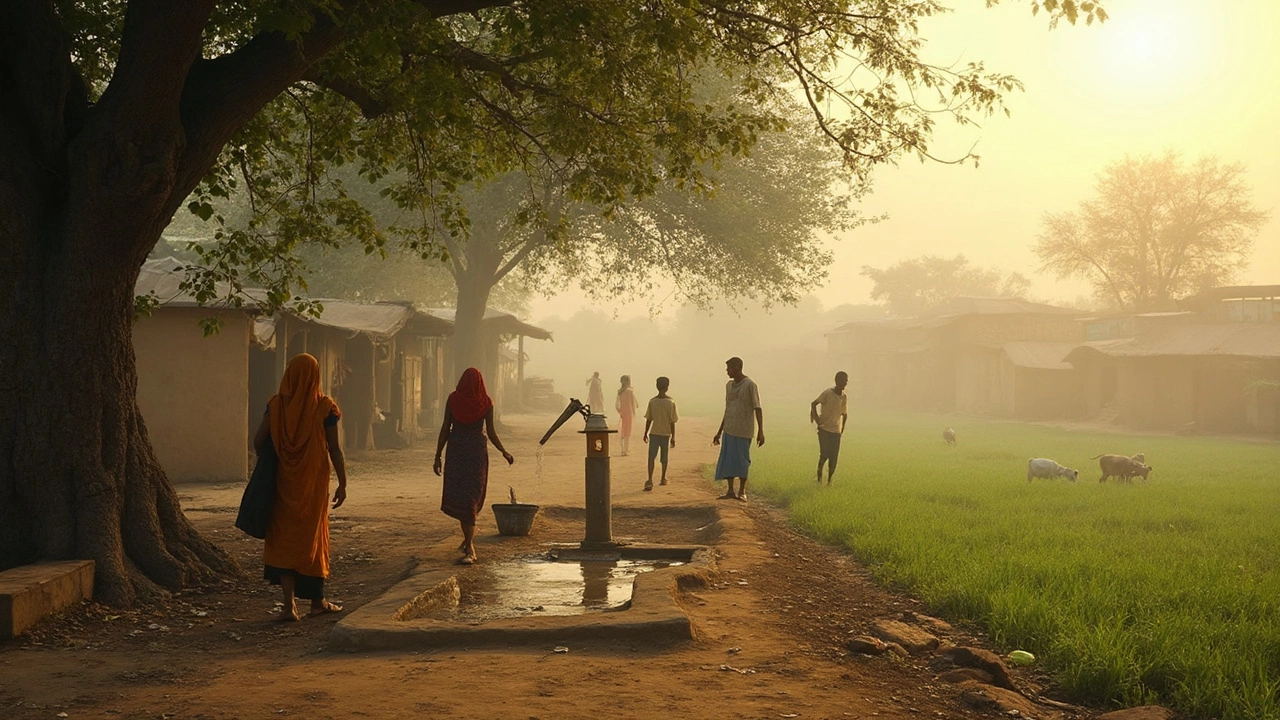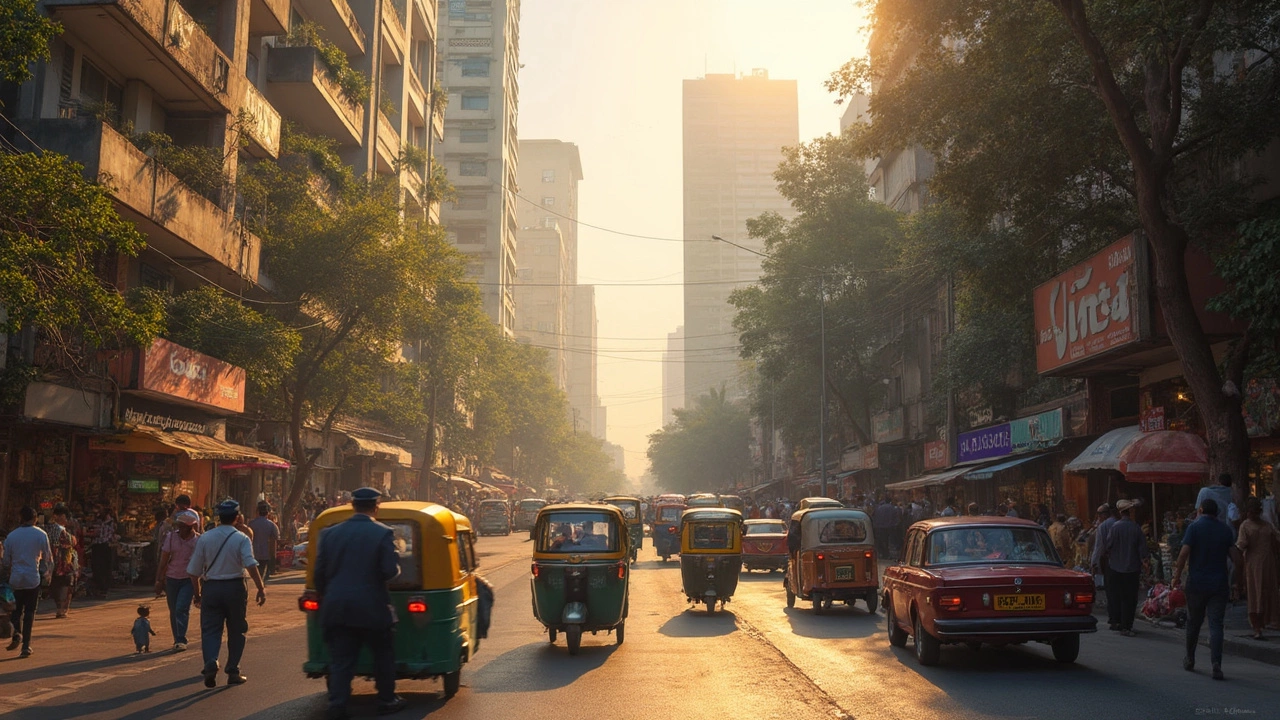When people talk about quality of life in India, two words pop up fast: contrast and change. It's not the same everywhere—life in Mumbai is a different planet compared to a village in Bihar. You’ll see folks driving luxury cars just down the street from street vendors selling tea for twenty rupees. This gap shapes how people live, work, and even dream.
Money’s one part, but a good life isn’t just about how fat your wallet is. Access to clean water, good schools, safe streets, and reliable hospitals can mean as much as a new pay raise, sometimes more. It might surprise you, but even in big cities, things like traffic jams can eat into your peace of mind. Don’t be shocked if it takes an hour to cover five kilometers in Bangalore rush hour—yup, that’s pretty normal.
You’ll notice that real “quality of life” here often boils down to the small stuff—good neighbors, a solid chai spot on the corner, or getting a seat on the Metro. People find their own ways to beat the chaos, and there are plenty of hacks to make everyday living smoother. Whether you’re new to India or thinking about a move across town, it makes sense to do your homework. A better life sometimes comes down to picking the right neighborhood or learning which apps deliver groceries fast when the shops are packed.
- The Urban-Rural Divide
- Health and Safety: How Secure Do You Feel?
- Work, Leisure, and What Really Matters
- Smart Life Tips for Living Better in India
The Urban-Rural Divide
If you ask anyone about the quality of life in India, you'll get wildly different answers depending on where they live. Almost 65% of Indians still live in rural areas, according to the 2021 census. Life in a small town or village moves at a slower pace, but the gap in basic services compared to cities is sometimes huge.
In cities like Delhi, Bengaluru, or Pune, you get access to better schools, top hospitals, gig-speed internet, malls, and global food chains. It isn’t perfect—urban air pollution is just brutal, and house rent can chew up most of your salary—but if you need an ambulance, a university, or Wi-Fi, you’ll find them fast. Even things like safe drinking water and electricity cuts are less of a headache in most city neighborhoods.
Villages and smaller towns can be a mixed bag. On the plus side, there’s cleaner air, close-knit communities, and a lot less honking. But public transport can be patchy or non-existent. Medical emergencies are trickier: 70% of doctors in India work in cities, so rural folks sometimes travel hours for a checkup. Quality of schools still depends on where you live, with state-run schools in some districts lagging behind their urban counterparts.
So why don’t more people leave villages behind for the city? Family, tradition, and land are big reasons. Plus, living costs are much lower outside big metros. A meal that costs ₹500 in Mumbai might cost only ₹80 in a remote town. But with India's tech boom, things are changing fast. More villages now have fiber-optic internet and there’s a growing number of rural youngsters studying online or working remote jobs.
- If you're deciding where to live in India, weigh the pros and cons: cities for better access to jobs and services, but higher costs and stress; rural areas for peace and space but less convenience.
- If you’re moving to a city from a rural area, learn about the local transport options and housing before making the jump—these are the biggest daily challenges.
- For folks in rural areas, look into government schemes for internet access and health insurance—they can help bridge some of the gap.
Health and Safety: How Secure Do You Feel?
Ask anyone who lives in India about what matters most for a good life and you’ll hear health and safety come up fast. It’s no secret—getting good medical care can depend a lot on where you live and how much you can spend. Big cities have high-end hospitals. There are world-class private ones in places like Delhi, Mumbai, and Chennai that people from even other countries visit. But step outside the main cities, and the story changes. In rural areas, basic healthcare can be tough to find. Sometimes folks travel for hours just to get a checkup.
Let’s talk numbers for a minute. India spends about 2% of its GDP on healthcare—less than what many other countries put in. There’s public healthcare, which is cheap, but crowded and sometimes underfunded. Then there’s private care—faster but can get expensive, especially if you don't have insurance. Here’s a quick comparison of key stats between urban and rural India:
| Indicator | Urban India | Rural India |
|---|---|---|
| Doctor-Patient Ratio | 1:1,800 | 1:10,000+ |
| Access to Hospitals (% households) | Over 85% | About 35% |
| Immunization Coverage | 86% | 68% |
Now, onto safety—crime rates often get lots of headlines. Most big cities have police stations nearby, and their apps can help in emergencies, but issues like theft or scams do pop up. Delhi and Mumbai, for example, record higher petty crime numbers compared to smaller towns. Women’s safety is a big topic, with late-night travel still feeling risky in a few places. Carrying pepper spray and using ride apps with GPS tracking are common tips, especially for newcomers.
- Use government health apps like Aarogya Setu for updates and nearby medical help.
- Keep copies of your medical records handy—digital or paper, both help in an emergency.
- Learn the local emergency numbers: 112 for all emergencies, 102 for ambulances.
- Stick to trusted transport options if you’re unfamiliar with a city, and double-check driver details on app-based rides.
Air quality is another part of the health picture. Cities like Delhi often see high pollution days—sometimes numbers cross 400 on the AQI index, which isn’t great for anyone’s lungs. Investing in a basic air purifier or wearing a mask during bad days isn’t just paranoia; it’s common sense. Every little step can make a big difference in your quality of life India experience.

Work, Leisure, and What Really Matters
If you want the real lowdown on the quality of life India has to offer, just ask someone about their job hours and weekend plans. Work culture across Indian cities and towns can be intense. In metros like Bangalore and Mumbai, young professionals often log 9-11 hour days—and don’t always get paid overtime. Work-from-home took off after 2020, but most offices switched back to hybrid or full-time in-person work by late 2023.
That doesn't mean it’s all grind. Family and social time score high on the Indian priorities list. You'll notice how public holidays, festivals, and family functions still trump work deadlines for most people. That mix of hustling and chilling keeps people going. For example, Diwali and Holi usually mean week-long breaks, with cities slowing down as folks travel back home or party with their communities.
When it comes to blowing off steam, the options depend a lot on where you live. Large cities are packed with malls, movie theaters, and cafés. Parks and gyms are popular, but green spaces can be limited, especially in crowded towns. Smaller cities or villages? Think board games at home, local cricket in the alley, or a drive to the nearest waterfall if you're lucky enough to have one nearby.
- Cricket and football are top picks for outdoor fun, both as a hobby and a community event.
- Binge-watching series on Netflix or Hotstar isn’t just a city trend—cheap internet means streaming is huge everywhere now.
- Clubs and nightlife draw crowds in metros, but safety and high prices keep many folks at home.
- Traditional get-togethers—like evening chai with neighbors—are a regular highlight, especially outside the big cities.
Money is only part of the story. Time with friends and family, personal health, and how safe or valued you feel make a real difference. Mental health talk, once taboo, is picking up now. Big firms started offering counsellors, “no meeting” days and gym memberships after surveys showed rising stress—nearly 40% of working professionals reported high stress in a study by LocalCircles in 2024.
| Aspect | Urban India | Rural India |
|---|---|---|
| Average Work Hours (per week) | 48+ (IT/Finance may be higher) | 60+ (agriculture and local business) |
| Public Holidays Annually | 15-18 | 18+ |
| Average Leisure Time (per day) | 1-2 hours | 2-4 hours |
| Main Source of Leisure | Tech/devices, gym, cafes | Social visits, local games |
Want a tip for a smoother work-life balance here? Try using calendar apps to ring-fence your free time—it’s easy to let WhatsApp work groups take over your evenings otherwise. And if you’re new in town, don’t skip the neighbourhood meetups. Local friends are the best shortcut to finding real fun outside work.
Smart Life Tips for Living Better in India
If you want to level up your day-to-day in India, you need some street smarts and local tricks. It's not just about surviving, but actually enjoying life here. Here’s how folks who know the ropes make things work—even when cities are busy and things feel unpredictable.
- Quality of life India is higher in cities with better infrastructure. City rankings in 2024 by Mercer put Hyderabad, Pune, and Bangalore at the top for public services, so if you can, try to live where roads, hospitals, and schools work smoothly.
- Download delivery and mobility apps. Swiggy, Zomato, Blinkit, and BigBasket save a crazy amount of time getting food and groceries. For transport, Ola and Uber beat crowded buses or unpredictable auto rickshaws.
- Filter your water. Tap water safety isn’t reliable anywhere—invest in a decent water purifier. Even in top cities, only 50-60% of homes report safe tap water access, according to the National Sample Survey Office.
- Think about air quality. Delhi, Kanpur, and Lucknow often have PM2.5 levels way above the World Health Organization’s safe limit. Use air purifiers at home and wear masks on bad days.
- Do your health checkups. Private hospitals offer better quality but can be pricey, so check if your job gives you insurance. Many people skip small clinics and use trusted apps like Practo to book doctors with real reviews.
- Live close to where you work or study. Commute times are no joke; Mumbai’s average daily commute can hit 90 minutes, says a 2023 survey by LocalCircles. Closer = less stress, more time for yourself.
Friends and neighbors make a huge difference. Even in huge apartment complexes or small neighborhoods, share numbers for electricians, plumbers, and grocers—local contacts help you solve issues faster than any customer service hotline.
Want a quick comparison of life in top Indian cities? Check out this handy table from recent Urban Livability Rankings (2024):
| City | Air Quality (Avg. AQI) | Tap Water Safety (%) | Av. Commute (mins) | Public Hospital Beds per 1,000 people |
|---|---|---|---|---|
| Bangalore | 89 | 61% | 65 | 2.2 |
| Hyderabad | 73 | 67% | 55 | 2.0 |
| Mumbai | 98 | 59% | 90 | 1.6 |
| Delhi | 197 | 51% | 80 | 2.1 |
So, whether you’re already in the thick of it or just planning your next move, these practical steps can seriously make life better here. You don’t have to change the world—just tweak the way you live in it!
